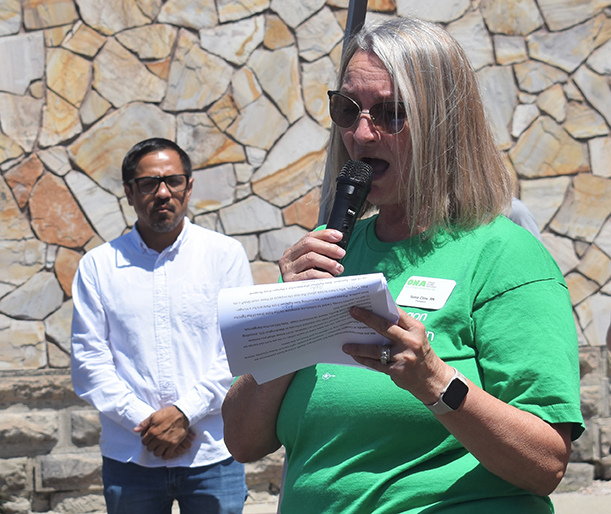COLUMN: Fear doesn’t change airlines’ sterling safety record
Published 9:32 am Monday, January 22, 2024

- Jacoby mug.jpg
When a hole rips open in a jetliner at 16,000 feet, a certain trepidation among the flying public is to be expected.
Not to mention the reaction of the passengers on that particular plane, Alaska Airlines Flight 1282, which took off from Portland International Airport on Jan. 5.
But fear, once it gets loose, typically is much faster, and more agile, than rational thought.
It is not without reason that “fear” is frequently preceded by “irrational.”
Humans’ ability to judge risk is notoriously poor.
This is to be expected, of course, with regard to flying.
Hurtling along while sitting inside a metallic tube at close to the speed of sound, 35,000 feet or more above the ground, is so foreign to our regular earthbound existence that the experience seems awfully dangerous.
If something serious goes wrong up there — or even much closer to the ground — our comparatively fragile bodies are essentially doomed, to be sure.
It’s basic physics.
Except something serious goes wrong so rarely that the risk to passengers on major U.S. airlines is so vanishingly small that, statistically speaking, it might as well not exist.
This has been true — irrefutably true — for nearly a quarter century.
And it has been true largely because we learned from our many mistakes.
When a fatal flaw happened in the past, whether the failure was of machine or man, government regulators and the airlines added that knowledge to the great wealth they have accumulated since jets largely replaced propeller-driven airliners in the 1950s.
These advances are discussed in compelling detail in episodes of one of my favorite TV shows — “Air Disasters.”
The title, I trust, needs no explanation.
What I find fascinating about the series is how many of these disasters were caused by an event, or, often, a sequence of events, that haven’t recurred since.
This is not a coincidence.
It is, rather, the product of a system that works far better than most tasks in which the federal government plays a prominent role.
Achieving that progress exacted a terrible toll, certainly.
Crashes have never been anything like common, but from the 1960s through the 1990s there were more than two dozen crashes in the U.S. in which 50 or more passengers died.
In several cases the death toll exceeded 150, with every soul aboard perishing — the awful suddenness of catastrophe that never happens on highways or railroads.
Yet the National Transportation Safety Board’s exhaustive investigations following these tragedies often yielded changes that have all but eliminated the possibility that the same factors could coincide again.
We have improved how we build and maintain airplanes, how we fly them in all weather and how we monitor them as they streak through the skies.
And yet, even as those skies have become increasingly crowded — more than 10 million scheduled passenger flights per year on average, according to the Federal Aviation Administration — the disasters simply have not happened in this country.
The last catastrophic crash, on the scale that marred previous decades, is more than 22 years in the past. American Airlines Flight 58 crashed just after takeoff in New York City on Nov. 12, 2001, killing all 260 aboard and five people on the ground.
The plane’s rudder broke off when a pilot put too much stress on the part while flying through turbulence from another jet.
The mistake has not been repeated.
Fifty people died, including one on the ground, when Colgan Air Flight 3407 crashed in New York in February 2009.
I have little doubt that investigators will figure out what happened to Alaska Airlines Flight 1282, the Boeing 737 Max 9 jet that departed Portland on Jan. 5.
Soon after takeoff, a door-sized section of the fuselage flew off, causing immediate decompression. Initial investigation suggests that four bolts, which are supposed to hold what’s known as a “door plug” in place, either were not secured properly or not installed at all.
The 2-foot by 4-foot plug covers a hole where an additional emergency exit can be installed if the airline orders it.
The FAA grounded all 737 Max 9 planes. That’s appropriate, and in keeping with the attitude that has been so instrumental in amassing what is to me a nearly miraculous safety record over the past two decades.
I don’t discount how serious the situation is following Flight 1282.
Failing to tighten, or even to install, bolts is the sort of thing that a backyard mechanic might do while tinkering with an old pickup truck or muscle car.
It should never happen with an airliner, obviously.
Still and all, some of the media accounts I’ve read since the Portland incident seem to me hyperbolic, if not hysterical. News stories and commentaries have been larded with phrases such as “gaping hole” and the “heavy blow” Boeing’s reputation has sustained.
The reality, of course, is that in this incident, frightening though it obviously was, no one died.
The aircraft, as tens of thousands of flights do every day in this country and have done for nearly a quarter century, landed safely.
A paragraph in a story from the Seattle Times epitomizes the brand of exaggeration I mentioned.
“Although all 171 of the grounded aircraft could well be back flying again within a month, inspecting and fixing those parts is now not enough for anyone to feel secure and safe again. The public needs reassurance that the entire aviation manufacturing system can be restored to producing quality airplanes without random life-threatening defects.”
It may well be true that whatever happens as a result of Flight 1282, the investigation and the changes I expect it will inspire, won’t make some people “feel secure and safe again.”
But how people “feel” has nothing to do with the reality that commercial air travel in this country is overwhelmingly safe.
The second sentence, though, is the more troubling.
The obvious implication of the word “restored” is that the aviation system is not now “producing quality airplanes without random life-threatening defects.”
Hence it must be restored to accomplish that feat.
I also read a column whose author opines that “it is clear now that we have not been very safe; instead, we have been very lucky.”
This strikes me as illogical.
Were jetliners riddled with loose or missing bolts and other defects — and worse still with problems that are random, which by definition could crop up at any time — then that nearly unblemished record of uneventful flights since 2001 in this country would have been not merely unlikely, but utterly impossible.
The notion that dumb luck could be responsible for tens of millions of flights to be made without mishap over more than two decades, each one requiring people to properly operate machines of immense complexity, and in a country with notably nasty weather and crowded airspace, is absurd.
That record, unlike human reactions, which are influenced by words and by emotions, is not a matter of feelings.
It’s a matter of fact.








